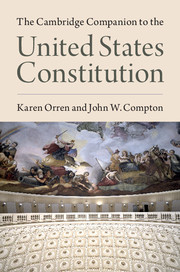41 results
Responsive States: Federalism and American Public Policy. By Andrew Karch and Shanna Rose. New York: Cambridge University Press, 2019. 252p. $99.99 cloth, $29.99 paper.
-
- Journal:
- Perspectives on Politics / Volume 18 / Issue 3 / September 2020
- Published online by Cambridge University Press:
- 08 September 2020, pp. 898-899
- Print publication:
- September 2020
-
- Article
- Export citation
Response to Andrew Karch and Shanna Rose’s Review of The Policy State: An American Predicament
-
- Journal:
- Perspectives on Politics / Volume 18 / Issue 3 / September 2020
- Published online by Cambridge University Press:
- 08 September 2020, p. 902
- Print publication:
- September 2020
-
- Article
- Export citation
The Adaptability Paradox: Constitutional Resilience and Principles of Good Government in Twenty-First-Century America
-
- Journal:
- Perspectives on Politics / Volume 18 / Issue 2 / June 2020
- Published online by Cambridge University Press:
- 23 September 2019, pp. 354-369
- Print publication:
- June 2020
-
- Article
-
- You have access
- HTML
- Export citation
Acknowledgments
-
- Book:
- The Cambridge Companion to the United States Constitution
- Published online:
- 06 February 2018
- Print publication:
- 22 March 2018, pp ix-x
-
- Chapter
- Export citation
Index
-
- Book:
- The Cambridge Companion to the United States Constitution
- Published online:
- 06 February 2018
- Print publication:
- 22 March 2018, pp 489-508
-
- Chapter
- Export citation
Introduction
-
-
- Book:
- The Cambridge Companion to the United States Constitution
- Published online:
- 06 February 2018
- Print publication:
- 22 March 2018, pp 1-6
-
- Chapter
- Export citation
Copyright page
-
- Book:
- The Cambridge Companion to the United States Constitution
- Published online:
- 06 February 2018
- Print publication:
- 22 March 2018, pp iv-iv
-
- Chapter
- Export citation
Part I - Principles
-
- Book:
- The Cambridge Companion to the United States Constitution
- Published online:
- 06 February 2018
- Print publication:
- 22 March 2018, pp 7-158
-
- Chapter
- Export citation
Part III - Actions
-
- Book:
- The Cambridge Companion to the United States Constitution
- Published online:
- 06 February 2018
- Print publication:
- 22 March 2018, pp 325-488
-
- Chapter
- Export citation
Contributors
-
- Book:
- The Cambridge Companion to the United States Constitution
- Published online:
- 06 February 2018
- Print publication:
- 22 March 2018, pp vii-viii
-
- Chapter
- Export citation
Contents
-
- Book:
- The Cambridge Companion to the United States Constitution
- Published online:
- 06 February 2018
- Print publication:
- 22 March 2018, pp v-vi
-
- Chapter
- Export citation
Part II - Structure
-
- Book:
- The Cambridge Companion to the United States Constitution
- Published online:
- 06 February 2018
- Print publication:
- 22 March 2018, pp 159-324
-
- Chapter
- Export citation

The Cambridge Companion to the United States Constitution
-
- Published online:
- 06 February 2018
- Print publication:
- 22 March 2018
Constitutional, Criminal, Civil
-
- Journal:
- The Review of Politics / Volume 76 / Issue 4 / Fall 2014
- Published online by Cambridge University Press:
- 30 September 2014, pp. 635-659
-
- Article
- Export citation
Cold Case File: Indictable Acts and Officer Accountability in Marbury v. Madison
-
- Journal:
- American Political Science Review / Volume 107 / Issue 2 / May 2013
- Published online by Cambridge University Press:
- 01 May 2013, pp. 241-258
- Print publication:
- May 2013
-
- Article
- Export citation
Doing Time: A Theory of the Constitution
-
- Journal:
- Studies in American Political Development / Volume 26 / Issue 1 / April 2012
- Published online by Cambridge University Press:
- 25 April 2012, pp. 71-81
-
- Article
- Export citation
Reply to Rogers Smith
-
- Journal:
- Journal of Policy History / Volume 8 / Issue 4 / October 1996
- Published online by Cambridge University Press:
- 14 October 2011, pp. 491-494
-
- Article
- Export citation
Structure, Sequence, and Subordination in American Political Culture: What's Traditions Got to Do with It?
-
- Journal:
- Journal of Policy History / Volume 8 / Issue 4 / October 1996
- Published online by Cambridge University Press:
- 14 October 2011, pp. 470-478
-
- Article
- Export citation
Have We Abandoned a “Constitutional Perspective” on American Political Development?
-
- Journal:
- The Review of Politics / Volume 73 / Issue 2 / Spring 2011
- Published online by Cambridge University Press:
- 28 April 2011, pp. 295-299
-
- Article
- Export citation
Union Politics and Postwar Liberalism in the United States, 1946–1979
-
- Journal:
- Studies in American Political Development / Volume 1 / Spring 1986
- Published online by Cambridge University Press:
- 16 December 2008, pp. 215-252
-
- Article
- Export citation



